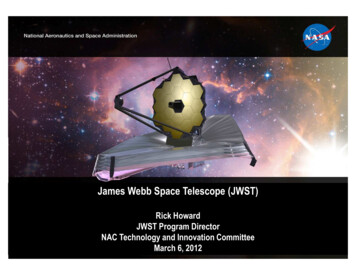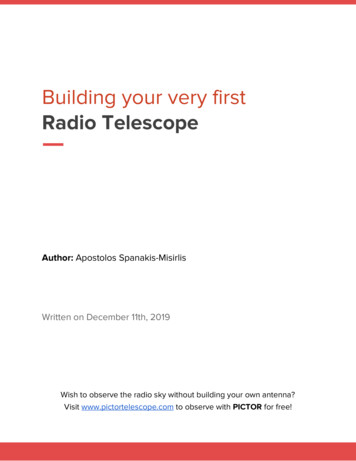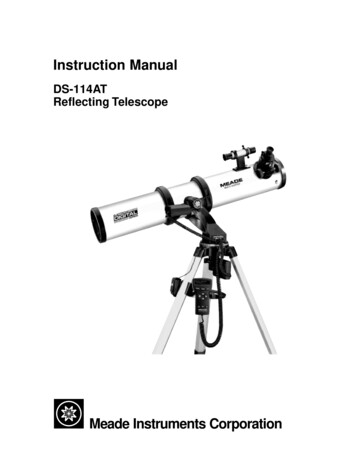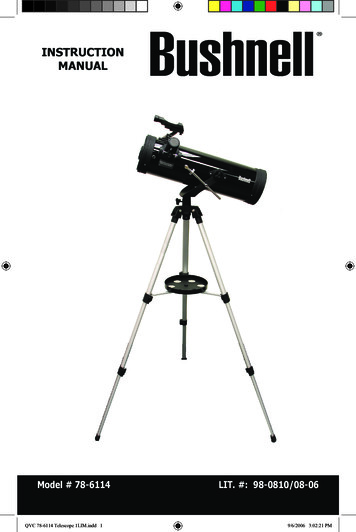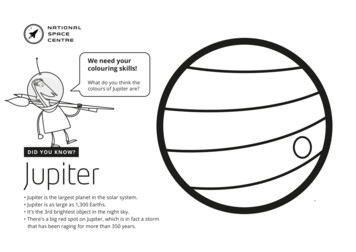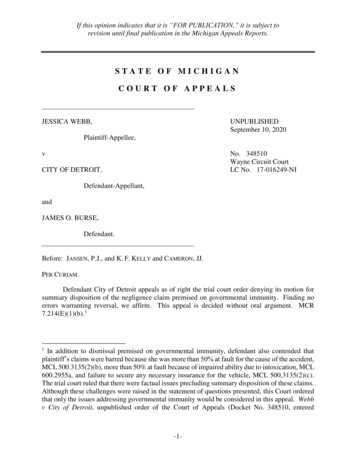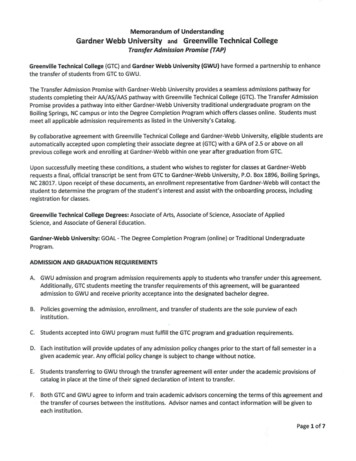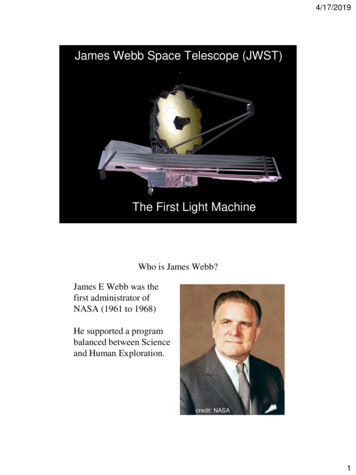
Transcription
4/17/2019James Webb Space Telescope (JWST)The First Light MachineWho is James Webb?James E Webb was thefirst administrator ofNASA (1961 to 1968)He supported a programbalanced between Scienceand Human Exploration.credit: NASA1
4/17/2019What is FIRST LIGHT?End of the dark ages: first light and reionizationWhat are the first luminous objects?What are the first galaxies?How did black holes form and interact with their host galaxies?When did re-ionization of the inter-galactic medium occur?What caused the re-ionization? to identify the first luminous sources toform and to determine the ionization history ofthe early universe.Hubble Ultra Deep FieldA Brief History of TimeGalaxiesEvolveFirst GalaxiesFormPlanets, Life &IntelligenceAtoms 00years100 millionyearsCOBEMAP1 billionyearsJWSTHST13.7 Billion yearsGroundBasedObservatories2
4/17/2019First Light StarsFirst stars (maybe 1000X larger than ourown) formed from clouds of hydrogen50-100 million years after the Big Bang.These first stars helped ionize the universe.Because they were so large, they quickly exploded supernovacreating elements such as He or collapsed into black holes.‘O’-class stars are25X larger thanour ‘G’-class Sun.The (modern) Morgan–Keenan spectral classification system, with the temperature range of each star class shown above it, in kelvin.The overwhelming majority of stars today are M-class stars, with only 1 known O- or B-class star within 25 parsecs. Our Sun is a Gclass star. However, in the early Universe, almost all of the stars were O or B-class stars, with an average mass 25 times greater thanaverage stars today.Wikimedia Commons user LucasVB, additions by E. SiegelEthan Siegel, FORBES.com, 24 Oct 2018First Light: ReionizationNeutral ‘fog’ was dissolved by very 1st Generation Stars.As indicated by Neutral Hydrogen spectroscopy, at 780 M yrsafter BB the Universe was up to 50% Neutral.But, by 1 B years after BB is was as we see it today.RedshiftNeutral IGMz ziLyman Forest Absorptionz ziPatchy Absorptionz zi.Black Gunn-Peterson troughSPACE.com, 12 October 20113
4/17/2019How do we see first light objects? RedshiftBlueRedGreen 5.8 Gyr2.2 Gyr3.3 Gyr1.8 Gyr2.2 Gyr1.0 GyrWhat is RedshiftThe further away an object is, the more its light is redshifted fromthe visible into the infrared – because of space/time stretching.To see really far away, we need an infrared telescope.4
4/17/2019First Galaxy in Hubble Deep FieldAt 480 M yrs after big bang (z 10) this one of oldestobserved galaxy. Discovered using drop-out technique.(current oldest is 420 M yrs after BB, maybe only 200 M yrs)Left image is visible light, and the next three in near-infraredfilters. The galaxy suddenly pop up in the H filter, at awavelength of 1.6 microns (a little over twice the wavelength theeye can detect). (Discover, Bad Astronomy, 26 Jan 2011)JWST Summary Mission Objective– Study origin & evolution of galaxies, stars & planetary systems– Optimized for near infrared wavelength (0.6 –28 m)– 5 year Mission Life (10 year Goal) Organization– Mission Lead: Goddard Space Flight Center– International collaboration with ESA & CSA– Prime Contractor: Northrop Grumman Space Technology– Instruments:– Near Infrared Camera (NIRCam) – Univ. of Arizona– Near Infrared Spectrometer (NIRSpec) – ESA– Mid-Infrared Instrument (MIRI) – JPL/ESA– Fine Guidance Sensor (FGS) – CSA– Operations: Space Telescope Science Institute5
4/17/2019NASA’s Fundamental Questions How Did We Get Here? Where Are We Going? Are We Alone?JWST Science ThemesFirst Light and Re-IonizationBig BangPlanetaryHH-30M-16Galaxy FormationLifeStar FormationGalaxy Evolution6
4/17/2019Three Key FactsThere are 3 key facts about JWST that enables it toperform is Science Mission:It is a Space TelescopeIt is an Infrared TelescopeIt has a Large ApertureWhy go to SpaceAtmospheric Transmission drives the need to go to space.Infrared (mid and far/sub-mm) Telescopes (also uv, x-ray, andgamma-ray) cannot see through the AtmosphereJWSTDiscoverySpace7
4/17/2019Infrared LightCOLDWhy Infrared ?8
4/17/2019Why do we need Large Apertures?10101700Rosse’s 72”Short’s 21.5”1800CCDsMount Palomar 200”Soviet 6-mPhotography1600Herschell’s 48”Adapted from CosmicDiscovery, M. HarwitGalileo102HuygenseyepieceSlow f ratiosSensitivity 106Improvementover the Eye 410Mount Wilson 100”108Photographic & electronic detectionTelescopes aloneHSTJWSTAperture Sensitivity19002000Sensitivity MattersGOODS CDFS – 13 orbitsHUDF – 400 orbits9
4/17/2019JWST will be more Sensitive than Hubble or SpitzerHUBBLEJWSTSPITZER0.8-meterT 5.5 K2.4-meterT 270 K6.5-meterT 40 K123” x 136”λ/D1.6μm 0.14”324” x 324”312” x 312”λ/D5.6μm 2.22” λ/D24μm 6.2”JWST 6X more sensitivewith similar resolution132” x 164”λ/D2μm 0.06”114” x 84”λ/D20μm 0.64”JWST 44X more sensitiveWavelength Coverage1 μm10 μm100 μmHSTJWSTSpitzerHow big is JWST?21st National Space Symposium, Colorado Springs, The Space Foundation10
4/17/2019How JWST WorksJWST is foldedand stowed for launchObservatory isdeployed after launchJWST Orbits the 2nd Lagrange Point (L2)239,000 miles (384,000km)930,000 miles (1.5 million km)EarthMoonL2JWST has 4 Science Instruments (0.6 to 28 micrometers)NIRCam: image the first galaxiesNIRSpec: simultaneous spectra of 100 galaxiesMIRI: first HD view of infrared universeFGS: sense pointing to 1 millionth degreeNIRISS: imagery & spectra of exoplanets11
4/17/2019JWST Telescope RequirementsOptical Telescope Element25 sq meter Collecting Area2 micrometer Diffraction Limit 50K ( 35K) Operating TempPrimary Mirror6.6 meter diameter (tip to tip) 25 kg/m2 Areal Density 6 M/m2 Areal Cost18 Hex Segments in 2 RingsDrop Leaf Wing DeploymentSegments1.315 meter Flat to Flat Diameter 20 nm rms Surface Figure ErrorLow (0-5 cycles/aper)4 nm rmsCSF (5-35 cycles/aper)18 nm rmsMid (35-65Kcycles/aper)7 nm rmsMicro-roughness 4 nm rmsFun Fact – Mirror Surface ToleranceHuman HairApproximate scaleDiameter is100,000 nm(typical)PMSA Surface Figure Error 20 nm (rms)PMSA12
4/17/2019Areal Density (Kg/m2)JWST Mirror Technology History300 240TRL-6 Testing2006NAR2004200JWST MirrorRisk ReductionTRL 6text100Goodrich Mirror6019801990302000SBMDBall BerylliumMirror2002Kodak ULE Mirror15JWST PrimaryOptic TechnologySelected - TRL 5.5text2010JWST WST PrimeSelectedAMSD Phase 2AMSD Phase 1NASA HST, Chandra,SIRTF Lessons Learned*- TRL 6 by NAR- Implement an active riskmanagement process early in theprogram ( Early investiment)Onset NGST1996Processimprovements\ RiskSelection,ReductionSeptember, 2003Mirror Material/Technology ScheduleTinsleystaffing identifiedBerylliumandchosenfor technicalreasons TE,AMSDPhase2 – thermal2000 conductance, issues withSIRTF Monolithic I70 Be Mirror 50.53Vendorsm diameterselectedfor hBeManufacturing stress3 vendors(Goodrich,Kodak, Study and 20m ROC otentialschedulesavings*studiesScheduleand TinsleystaffingBall) BerylliumBallandNMSD EDU rorJWSTrisksITT/Kodak (ULE)Cryo NullDownselectFiguredto4asmirrortooptions,19 g ProcessCoating improvementsAdheasionGoodrichdropped from(couponAMSD and .5Phase 3 architecturesmeter demonstrations)SBMDBased on lessons learned, JWST invested early in mirror technology to addresslower areal densities and cryogenic operationsAdvantages of BerylliumVery High Specific Stiffness – Modulus/Mass RatioSaves Mass – Saves MoneyHigh Conductivity & Below 100K, CTE is virtually zero.Thermal Stability13
4/17/2019Figure Change: 30-55K Operational RangeULE GlassBerylliumYYYSurface FigureWith AlignmentCompensationXXVertexX15.0 mm15.0 mmGravityGravityVertexYResidual with36 ZernikesRemovedXYXVertex15.0 mm15.0 mmGravityGravityVertexMirror Manufacturing ProcessBlank FabricationMachiningCompleted Mirror BlankMachining of Web StructureMachining of Optical SurfacePolishingMirror System Integration14
4/17/2019Fun Facts – Mirror ManufacturingBeforeAfterFinishedMirrorSegmentBe BilletBe dust which isrecycled250 kgs21 kgsOver 90% of material is removed to make each mirror segment – want a little mirror with your Be dust?Mirror Processing at Tinsley15
4/17/2019Tinsley In-Process Metrology ToolsMetrology tools provide feedback at every manufacturing stage:Rough GrindingCMMFine Grinding/Rough PolishingScanning Shack-HartmannFinal Polishing/Figuring/CNFInterferometryPMSA Interferometer Test Stations included:2 Center of Curvature CGH Optical Test Stations (OTS1 and OTS2)Auto-Collimation Test StationData was validated by comparing overlap between toolsIndependent cross check tests were performed at Tinsley andbetween Tinsley, Ball and XRCF.Leitz CMMCMM was sized to test PMSA Full Aperture16
4/17/2019Wavefront Sciences Scanning Shack-HartmannSSHS provided bridge-data between grind and polish, used untilPMSA surface was within capture range of interferometrySSHS provide mid-spatial frequency control: 222 mm to 2 mmLarge dynamic range (0 – 4.6 mr surface slope)When not used, convergence rate was degraded.Comparison to CMM (222 - 2 mm spatial periods)8/1/2006 dataSmooth grindSSHS4.7 µm PV, 0.64 µm RMSCMM4.8 µm PV, 0.65 µm RMSPoint-to-Point Subtraction: SSHS - CMM 0.27 µm RMS17
4/17/2019Full Aperture Optical Test Station (OTS)Center of Curvature Null Test measured & controlled:Prescription,Radius &FigureResults are cross-checked between 2 test stations.InterferometerPrimary Segment MountCGHFold FlatADM M1 M2Interferometer M3CGHFull Aperture Optical Test Station (OTS)18
4/17/2019Test Reproducibility(OTS-1 Test #1 vs. Test #2) VC6GA294-VC6HA270Power(RadiusDelta: 0.02mm)Astigmatism:4.4 nm RMSMid Frequency:4.3 nm RMSTotal Surface Delta:PV: 373 nmRMS: 7.6 nmHigh Frequency:3.9 nm RMSAuto-Collimation TestAuto-Collimation Test provides independentcross-check of CGH Center of Curvature TestVerifies:Radius of CurvatureConic ConstantOff-Axis DistanceClockingNote: is not a full-aperture figure verification test19
4/17/2019Primary Mirror Segment Assembly at BATCBall Optical Test Station (BOTS)Tinsley ambient metrology results are ‘cross-checked’ at BATCBOTS measurements:Measure Configuration 1 to 2 deformationMeasure Configuration 2 to 3 deformationCreate a Gravity Backout file for use at XRCFMeasure Vibration Testing DeformationMeasure Vacuum Bakeout DeformationMeasure Configuration 2 mirrors for BATC to Tinsley Data CorrelationInterferometerEnvironmental EnclosureCGH6 DOF Test Stand and MirrorEnclosure Door20
4/17/2019BOTS to Tinsley Initial ComparisonPowerAstigmatismMid FrequencyInitially, BOTS and TOTS Radius did not agree.Discrepancy was determined to be caused bybulk temperature difference. Agreement is nowat 10 nm rms level.High FrequencyPMSA Flight Mirror Testing at MSFC XRCFCryogenic Performance Specifications are Certified at XRCFGate ValveHe ShroudsOptical TestEquipment5DOF TableCryo-Vacuum Chamber is 7 m dia x 23 m long21
4/17/2019JWST Flight Mirror Test Configuration100”He ightingFacility Optical Axis61.69”Table andStand-OffsFacility FloorTable positioningActuators, 3 placesPrimary Mirror Cryogenic Tests22
4/17/2019XRCF Cryo TestCryotest #6 TimelineCycle 2Cycle re -11 C3 Cryo DeploymentNominal MeasurementHexapod Deformation PoseRoC Actuation TestHexapod Envelope TestPullout Current & RedundantTest (3 of 6 PMSAs) Set RoCNominal MeasurementHexapod Tilt TestPullout Current & RedundantTest (3 of 6 PMSAs)Mirror FabricationFlight MirrorsSpare MirrorsB8EDUSM#213.5 nm-rms(A type)5.9 nm-rmsC1C614.9 nm-rms10.0 nm-rms10.4 nm-rmsB7A1B213.0 nm-rms15.3 nm-rms13.1 nm-rmsC7238 nm-rmsA6A218.0 nm-rms16.5 nm-rmsC5A3A59.6 nm-rms15.3 nm-rms8.0 µm-rms4.3 nm-rms15.4 nm-rms14.9 nm-rmsB1TMC2PMS’sB6A4B3FSM15.2 nm-rms9.5 nm-rms8.2 nm-rms2.3 nm-rmsSM#1C4C333 nm-rms15.4 nm-rms14.2 nm-rmsB58.5 nm - rmsSURFACE FIGURE ERRORTotal PM Composite:PM Requirement:23.2 nm RMS25.0 nm RMSJames Webb Space Telescope: large deployable cryogenic telescope in space. Lightsey, Atkinson, Clampin and Feinberg, Optical Engineering 51(1), 011003 (2012)23
4/17/2019Gold Coated Mirror AssembliesMirrors 98% at 2 ical Telescope Assembly24
4/17/2019Observatory level testing occurs at JSC Chamber AVerification Test Activities in JSC Chamber-ACryo PositionMetrologyPrimary MirrorStability TestFocus Sweep Test(inward facingsources)SMPGPGAOSPGPGPMCrosscheck Tests in JSC Chamber-APupil Alignment TestPrimary MirrorWFE TestRogue Path TestPass-and-aHalf TestEnd-to-End WFSCDemonstrationChamber A: 37m tall, 20m diameter, 12m door LN2 shroud and GHe panelsEnd-to-end optical testing at JSC July 2017 to Nov 20185025
4/17/2019Telescope & instrument module now at Northrop Grummanfor integration with the spacecraft bus and sunshieldSpace Telescope Transporter for Air Road and Sea (STTARS)51Integration of Telescope with Spacecraft & Sunshade at Northrop26
4/17/2019Mobile Cleanroom Moves JWST to Vibe Test at NorthropNorthrop Grumman, 2018JWST will be transported by ship through Panama Canalto French Guiana for launch during March 2021Roll on roll off transport ship built in the Netherlands by Merwede Shipyards Length 116m Displacement about 4200 metric tons Garage deck length 95m (plenty of room for STTARS) Speed: 15 knots6900 Nautical MilesApproximately 20 daysSpace Telescope Transporter for Air Road and Sea (STTARS)27
4/17/2019JWST Launched on Ariane 5 HeavyJWST folded and stowed for launchin 5 m dia x 17 m tall fairingFrench GuianaLaunch from Kourou Launch Center(French Guiana) to L2JWST vs. HST - orbitSunEarthMoonHST in Low Earth Orbit, 500 km up.Imaging affected by proximity to EarthSecond Lagrange Point,1,000,000 miles awayJWST will operate at the 2nd Lagrange Point (L2) which is 1.5Million km away from the earthL25628
4/17/2019L2 Orbit Enables Passive Cryogenic OperationSecond Lagrange Point (L2) of Sun-Earth SystemThis point follows the Earth around the SunThe orbital period about L2 is 6 monthsStation keeping thrusters required to maintain orbitPropellant sized for 11 years (delta-v 93NorthEclipticPole5 45 1.6 x 106 kmContinuousCoverageZone NorthẐX̂1.0 x 106 kmYˆL25.0 x 105 kmEarthTowardthe SunLunar Orbit360 ContinuousCoverageZone South1.5 x 106 kmJWST observes whole sky while remainingcontinuously in shadow of its sunshieldField of Regard is annulus covering 35% of the skyWhole sky is covered each yearJWST Deployment29
4/17/2019JWST Science Theme #1End of the dark ages: first light and reionizationWhat are the first luminous objects?What are the first galaxies?How did black holes form and interact with their host galaxies?When did re-ionization of the inter-galactic medium occur?What caused the re-ionization? to identify the first luminous sources toform and to determine the ionization history ofthe early universe.Hubble Ultra Deep FieldStudying Early Universe: ‘First’ GalaxiesNASA, ESA, B. Robertson (University of California, Santa Cruz), A. Feild umbnails/image/image2i1607bw.jpgGalaxy GN-z11 is 13.4 B-yrs away, just 400 M-yrs after BB.It is 25X smaller than and has only 1% the mass of Milky Way,but is forming stars 20X faster (produced by large gas inflow).Some ‘first’ galaxies formed stars 1000X faster than today.30
4/17/2019First Galaxies form in Cosmic WebRipples in the early universeformed long filaments of hydrogengas surrounded by ‘dark matter’.Galaxies form at crossing points.Most of universe’s matter is inthese filaments and dark matter.This one is 10B light years away.A filament of the universe’s “cosmic web” is highlighted withparallel curved lines in this image, while a protogalaxy isoutlined with an ellipse. The brightest spot (on the lower rightside of the ellipse) is the quasar UM287. The other bright spotis a second quasar in the system. The image combines avisible light image with data from the Cosmic Web Imager.CREDIT: Chris Martin/PCWI/CaltechCharles Choi, Space.com, 5 Aug 2015.Hubble Ultra Deep Field – Near InfraredNear-Infrared image taken with new Wide-Field Camera 3 wasacquired over 4 days with a 173,000 second exposure.31
4/17/2019Hubble Ultra Deep Field – Near Infrared47 Galaxies have been observed at 600 to 650 Myrs after BB.Hubble Ultra Deep Field – Near Infraredoverlaid with Chandra Deep Field SouthCREDIT: X-ray: NASA/CXC/U.Hawaii/E.Treister et al;Optical: NASA/STScI/S.Beckwith et alKeith Cooper, Astronomy Now, 15 June 2011Taylor Redd, SPACE.com, 15 June 2011What came first – Galaxies or Black Holes?Each of these ancient 700 M yrs after BB galaxies has a black hole.Only the most energetic x-rays are detected, indicating that the black-holes areinside very young galaxies with lots of gas.32
4/17/2019First Black HolesOne theory for ‘first’ black holes is direct collapse of ‘first’ stars.Below shows disappearance of 25X times our Sun star without a supernova.The visible/near-IR photos from Hubble show a massive star, about 25 times the mass of the Sun, that has winked out of existence,with no supernova or other explanation. Direct collapse is the only reasonable candidate explanation.NASA/ESA/C. Kochanek (OSU)Ethan Siegel, FORBES.com, 24 Oct 2018WISE is Wide-Field IR ‘finder scope’ for JWSTWISE has found millions of black holes in galaxies previouslyobscured by dust called hot DOGs, or dust-obscured galaxies.Nancy Atkinson , Universe Today, on August 29, 201233
4/17/2019Oldest & Brightest Quasar – 770M yrs after BBThis Quasar is 770 million years after Big Bang, ispowered by a black hole 2 billion times the massof our Sun and emits 60 trillion times as muchlight as the sun. How a black hole became somassive so soon after the Big Bang is unknown.“It is like finding a 6-foot-tall child in kindergarten,”says astrophysicist Marta Volonteri, at the Universityof Michigan in Ann Arbor.The spectra of the light from this (and other earlylight objects) indicate that the Universe was stillfilled with significant amounts of neutralhydrogen even 770 Myrs after big bang.Image of ULASJ1120 0641, a verydistant quasar powered bya black hole with a mass 2billion times that of thesun, was created fromimages taken from surveysmade by both the SloanDigital Sky Survey andthe UKIRT Infrared DeepSky Survey. The quasarappears as a faint red dotclose to the centre.CREDIT:ESO/UKIDSS/SDSSNadia Drake , Science News, 29 June 2011Charles Q. Choi, SPACE.com, 29 June 2011Unexpected “Big Babies”: 800M yrs after BBSpitzer and Hubble haveidentified a dozen very old(almost 13 Billion light yearsaway) very massive (up to10X larger than our MilkyWay) galaxies.At an epoch when theUniverse was only 15% ofits present size, and 7% ofits current age.This is a surprising resultunexpected in current galaxyformation models.Michael Werner, “Spitzer Space Telescope”, William H. Pickering Lecture, AIAA Space 2007.34
4/17/2019JWST Science Theme #2:The assembly of galaxiesHow did the heavy elements form?How is the chemical evolution of the universe related to galaxyevolution?What powers emission from galaxy nuclei?When did the Hubble Sequence form?What role did galaxy collisions play in their evolution?Can we test hierarchical formation and global scaling relations?What is relation between Evolution of Galaxies &Growth/Development of Black Holes in their nuclei? to determine how galaxies and the dark matter, gas, stars,metals, morphological structures, and active nuclei within themevolved from the epoch of reionization to the present day.M81 by SpitzerFormation of Heavy ElementsCarl Sagan said that we are all ‘star dust’.All of the heavy elements which exist in theuniverse were formed from Hydrogen insideof stars and distributed via supernovaexplosions. But observations in the visiblecouldn’t find enough dust.Dust is cold, therefore, it can only be seen in IR.Looking in the IR (with Herschel and Spitzer) atSupernova 1987A, 100,000X more dust wasseen than in the visible – the total mass ofthis dust equals about half of our Sun.Image of Supernova 1987A, taken in theinfrared by Herschel and Spitzer, showssome of the warm dust surrounding it.CREDIT: Pasquale PanuzzoSPACE.com, Taylor Redd, 7 July 201135
4/17/20192nd Generation Stars – 700M yrs after BBThis star is a 2nd generation star after the big bang because it hastrace amounts of heavy elements – meaning that at least onesupernova had exploded before it was formed.But its existence contradicts current theories because it has toomuch Hydrogen and too much Helium and not enough Carbonand other heavy elements.Nola Taylor Redd, SPACE.com, 31 August 2011; CREDIT: ESO/Digitized Sky Survey 2Subaru Deep Field: Ancient Supernova 3.7B yrs after BB22 of 150 ancient supernovae in 10% of Subaru Deep Field12 occurred around 3.7B yrs after big bang.Supernova were 10X more frequent at this time than today.Supernova helped seed early universe with chemical elements.Clara Moskowitz, SPACE.com, 05 October 201136
4/17/2019The Hubble SequenceHubble classified nearby (present-day) galaxies intoSpirals and Ellipticals.The Hubble Space Telescope hasextended this to the distant past.Distant Galaxies are “Train Wrecks”37
4/17/2019Merging Galaxies Merging Black HolesCombined Chandra & Hubble data shows two black holes (one30M & one 1M solar mass) orbiting each other – separated by490 light-years. At 160 million light-years, these are theclosest super massive black holes to Earth.Theory says when galaxies collidethere should be major disruptionand new star formation.This galaxy has regular spiral shapeand the core is mostly old stars.These two galaxies merged withminor perturbations.Galaxy NGC3393 includes two active black holesX-ray: NASA/CXC/SAO/G.Fabbiano et al; Optical: NASA/STScICharles Q. Choi, SPACE.com, 31 August 2011Galaxy ClustersGalaxy clusters are the largest structures inthe universe. Bound together by gravity,they require billions of years to form.Galaxy Clusters have been detected as early at0.6 B-yrs after big bang.At 2.6 B-yrs old, this is not the oldestobserved galaxy cluster. But, spectraindicates that stars in its constituentgalaxies are 1 B-yrs old. Thus, may havestarted forming about 1.5 B-yrs after BB.X-ray data (similar to image) shows glowfrom cloud of very hot gas that holdscluster together. Most of the mass of thecluster is in the gas.Hubble NIR Image of CL J1449 0856,the most distant mature cluster ofgalaxies found. Color added from ESO’sVLT and NAOJ’s Subaru Telescope.CREDIT: NASA, ESA, R. Gobat (SPACE.com09 March 2011 )JKCS 041 at 3.7 B-yr after BB may beone of the Universe's oldest clusters. InChandra image, X-ray emission is shownin blue. Image: NASA/CXC/INAF/S.Andreon(Astronomy Now, 10 May 2010)38
4/17/2019JWST Science Theme #3:Birth of stars and protoplanetary systemsHow do molecular clouds collapse?How does environment affect star-formation?What is the mass distribution of low-mass stars?What do debris disks reveal about the evolution of terrestrial planets? to unravel the birth and early evolution ofstars, from infall on to dust-enshroudedprotostars, to the genesis of planetary systems.David HardyBirth of Stars and Proto-planetary SystemsDeeply embedded protostarAgglomeration & planetesimalsCircumstellar diskMature planetary system39
4/17/2019How does environment affect star-formation?Massive stars produce wind & radiationEither disrupt star formation, or causes it.Boundary between smallest browndwarf stars & planets is unknownDifferent processes? Or continuum?JWST Observations:Survey dark clouds, “elephant trunks” or“pillars of creation” star-forming ytheHSTinfraredSpitzer hasFound“TheMountainsOfCreation”Michael Werner, “SpitzerSpace Telescope”, WilliamH. Pickering Lecture, AIAASpace 2007.L. Allen, CfA [GTO]40
4/17/2019The Mountains Tell Their TaleInterstellar erosion & star formationpropagate through the cloudYoung (Solar Mass) Stars areShown in This PanelReally Young Stars are Shown inThis PanelMichael Werner, “Spitzer Space Telescope”, William H. Pickering Lecture, AIAA Space 2007.Stellar ShockwaveShockwave created by Zeta Ophiuchi which is moving towardsthe left at about 24 kilometres per second.STARSTUFF IMAGE by Stuart Gary, ABC Science, 20 July 201541
4/17/2019Star Formation in Dust/Gas CloudHerschel discovered 700 newly-forming stars condensing along filaments ofdust in a never before penetrated dark cloud at the heart of Eagle Nebula.Two areas glowing brightest in icy blue light are regions where large newbornstars are causing hydrogen gas to shine.SPACE.com 16 December 2009Cosmic Breeding Ground for Young StarsPhotos via ESA/Herschel/PACS, SPIRE/Hi-GAL Project. Acknowledgement: UNIMAP / L. Piazzo, La Sapienza – Università di Roma; E. Schisano / G. Li Causi, IAPS/INAF, ItalyComposite image of molecular cloud RCW106 using Herschel.Cloud itself consists of (color coded) gases: hydrogen, oxygen, carbon.Young stars are creating pockets in the cloud.Blue is hot.Cassie Kelly, Dope Space Pics, February 27, 201742
4/17/2019Impossible Stars100 to 150 solar mass stars should not existbut they do.When a star gets to 8 to 10 solar mass itswind blows away all gas and dust,creating a bubble and stopping itsgrowth (see Herschel Image).The bubble shock wave is creating a dense2000 solar mass region in which an‘impossible’ star is forming. It isalready 10 solar mass and in a few 100thousand years will be a massive 100 to150 solar mass – making it one of thebiggest and brightest in the galaxy.Image of RCW 120 (ESA),Discover.com, Ian O’Neill, 7 May 2010(Space.com, 6 May 2010)Orion Nebula Protoplanetary DiscsHubble has discovered 42protoplanetary discs in theOrion NebulaCredit: NASA/ESA and L. Ricci (ESO)43
4/17/2019All of Life’s Ingredients Found in Orion NebulaHerschel Telescope has measured spectra for all the ingredientsfor life as we know them in the Orion Nebula.(Methanol is a particularly important molecule)Wired.com Mar 2010JWST Science Theme #4:Planetary systems and the origins of lifeHow do planets form?How are circumstellar disks like our Solar System?How are habitable zones established? to determine the physical and chemicalproperties of planetary systems including ourown, and to investigate the potential for theorigins of life in those systems.Robert Hurt44
4/17/2019Planetary Formation Questions and 2 ModelsUltima ThuleNew Horizons’ image of Ultima Thule on1 Jan 2019 supports the Accretion Modelof Planetary System Formation.45
4/17/2019History of Known (current) NEO Population199019501900180019992006The Inner Solar System in 2006EarthCrossingOutsideEarth’sOrbitKnown 340,000minor planets 4500 NEOs 850PotentiallyHazardousObjects (PHOs)ScottManleyLandis, “Piloted Flight to a Near-Earth Object”, AIAA Conference 19 Sep 07ArmaghObservatoryProtoplanetary Disks are Ubiquitous & DiversePlanets form in the gaps and spiral arms.Catherine Espaillat (Boston University), Disks to Planets: Observing Planet Formation in Disks Around Young Stars, AAS 201946
4/17/2019Direct Imaging of Planet FormationALMA is mm/sub-mm 15-kmbaseline array telescope producinga 35 mas resolution image. (10 mtelescope at 500 nm has 10 mas)HL Tau is 1 million year old ‘sunlike’ start 450 light-years fromEarth in constellation Taurus.Concentric rings separated by gapssuggest planet formation.HL Tau is hidden in visible lightbehind a massive envelope of dustand gas. ALMA wavelength seesthrough dust.Our Planetary SystemALMA image of the young star HL Tau and its protoplanetary disk. This bestimage ever of planet formation reveals multiple rings and gaps that herald thepresence of emerging planets as they sweep their orbits clear of dust and gas.Credit: ALMA (NRAO/ESO/NAOJ); C. Brogan, B. Saxton (NRAO/AUI/NSF)Catherine Espaillat (Boston University), Disks to Planets: Observing Planet Formation in Disks Around Young Stars, AAS 201947
4/17/2019Spiral Arms Hint At The Presence Of PlanetsDisk of gas and dust around a sun-like star has spiral-arm-likestructures. These features may provide clues to the presence ofembedded but as-yet-unseen planets.Near Infrared image from SubaruTelescope shows disk surrounding SAO206462, a star located about 456 lightyears away in the constellation Lupus.Astronomers estimate that the system isonly about 9 million years old. The gasrich disk spans some 14 billion miles,which is more than twice the size ofPluto's orbit in our own solar system.Photonics Online 20 Oct 201110 Jupiter Mass20 AU from starCatherine Espaillat (Boston University), Disks to Planets: Observing Planet Formation in Disks Around Young Stars, AAS 201948
4/17/2019Protoplanetary disks are complex and dynamicCatherine Espaillat (Boston University), Disks to Planets: Observing Planet Formation in Disks Around Young Stars, AAS 2019Protoplanetary disk observations require multiple wavlengthsJWSTCatherine Espaillat (Boston University), Disks to Planets: Observing Planet Formation in Disks Around Young Stars, AAS 201949
4/17/2019Eta Corvi SystemALMA measures ‘cold’ Kuiper belt debris.Spitzer measures ‘warm’ asteroid belt debris.JWST will provide higher resolution image of asteroid belt.MacGregor, Disks in Nearby Planetary Systems with JWST and ALMA, AAS 2019Habitable ZoneLife requires water. Liquid water can only exist in the‘Goldilocks'’ Zone. The hotter the star, the further away the llions of stars' in the Milky Way may have planets that contain alien life, Ellie Zolfagharifard, Dailymail.com, 18 M
Mirror Manufacturing Process Polishing Mirror System Integration Blank Fabrication Machining of Optical Surface Machining Machining of Web Struct
